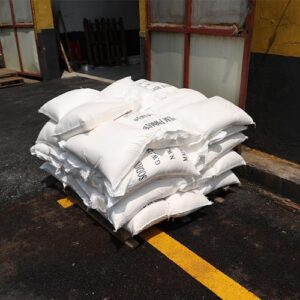Введение
Buffering agents play a crucial role in maintaining stable pH conditions during chemical reactions. Sodium formate, a versatile chemical compound, has gained attention for its potential as a buffering agent in various chemical processes. This article delves into the complexities of sodium formate’s role as a buffering agent, exploring its properties, mechanisms, applications, and its effectiveness in maintaining optimal pH conditions during chemical reactions.
Understanding Sodium Formate as a Buffering Agent
Что такое формиат натрия?
формиат натрия (HCOONa) is a sodium salt derived from formic acid (HCOOH), known for its water solubility and diverse applications across industries.
Buffering Agent Function and Importance
1. Role of Buffering Agents
Buffering agents are substances that resist changes in pH by neutralizing excess acids or bases, thereby maintaining a stable pH environment during chemical reactions.
2. Importance in Chemical Reactions
Maintaining a consistent pH is critical in chemical reactions, as pH fluctuations can affect reaction rates, product formation, and overall reaction outcomes.
Sodium Formate as a Buffering Agent: Mechanisms and Properties
1. Acid-Base Equilibrium
формиат натрия acts as a buffering agent by participating in an acid-base equilibrium. It can dissociate to release formate ions (HCOO-) that react with excess H+ ions or OH- ions, stabilizing pH levels.
2. Optimal pH Range
Sodium formate’s buffering capacity is most effective within a specific pH range, typically around its pKa value (approximately 3.75). This range aligns with its dissociation constant and optimal buffering capacity.
3. Chemical Stability
формиат натрия‘s chemical stability and solubility make it suitable for various reactions, including those requiring controlled pH conditions.
Applications of Sodium Formate as a Buffering Agent

1. Chemical Synthesis
Sodium formate is used as a buffering agent in chemical synthesis to control pH during reactions. This ensures consistent reaction rates and product yields.
2. Biotechnology and Pharmaceuticals
In biotechnological and pharmaceutical processes, maintaining specific pH conditions is essential for enzyme activity and product stability. Sodium formate’s buffering capacity aids in achieving optimal pH levels.
3. Analytical Techniques
Sodium formate is employed as a buffering agent in analytical techniques, such as high-performance liquid chromatography (HPLC) and mass spectrometry, where precise pH control enhances accuracy.
Effectiveness and Burstiness in Buffering Reactions
1. pH Control Precision
Sodium formate’s effectiveness as a buffering agent lies in its ability to maintain pH within a defined range. Its burstiness emerges when it reacts with varying concentrations of H+ or OH- ions, preventing pH shifts.
2. Reaction Rate Optimization
By stabilizing pH conditions, sodium formate contributes to optimizing reaction rates. Burstiness occurs as the buffering agent ensures that reaction kinetics remain consistent.
Considerations and Challenges
1. Compatibility with Reactants
Sodium formate’s compatibility with reactants and reaction conditions is essential. Some reactions may involve incompatible substances or conditions that affect its buffering effectiveness.
2. Buffering Capacity
The buffering capacity of sodium formate may be limited in extreme pH ranges, affecting its suitability for reactions requiring highly acidic or alkaline conditions.
FAQ about Sodium Formate as a Buffering Agent
Q1: Can sodium formate replace other buffering agents in all reactions?
A1: Sodium formate’s effectiveness as a buffering agent depends on factors such as the desired pH range, reaction conditions, and compatibility with reactants. It may replace other buffering agents in some reactions but not all.
Q2: Is sodium formate suitable for biological reactions?
A2: Sodium formate can be used in biological reactions, provided that the desired pH range aligns with its optimal buffering capacity. Compatibility with biological molecules and enzymes should be considered.
Q3: How does sodium formate compare to traditional buffering agents?
A3: Sodium formate’s effectiveness as a buffering agent may vary compared to traditional agents like acetate or phosphate buffers. The choice depends on the specific reaction requirements and conditions.
Q4: Can sodium formate be used in large-scale industrial processes as a buffering agent?
A4: Sodium formate’s usage as a buffering agent in large-scale processes depends on its buffering capacity, cost-effectiveness, and compatibility with industrial conditions.
Вывод
Sodium formate’s potential as an effective buffering agent in chemical reactions stems from its acid-base equilibrium properties and optimal pH range. Its role in maintaining stable pH conditions contributes to consistent reaction outcomes, reaction rate optimization, and enhanced precision in various applications. While challenges related to compatibility and buffering capacity exist, sodium formate’s versatility positions it as a valuable tool in achieving controlled pH environments during chemical processes.


